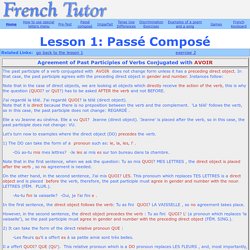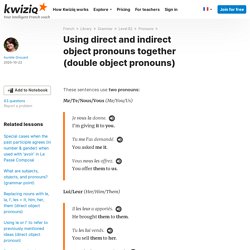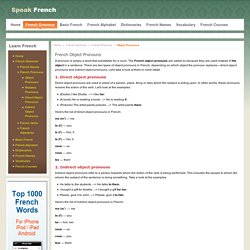

French Tutor. The past participle of a verb conjugated with AVOIR does not change form unless it has a preceding direct object.

In that case, the past participle agrees with the preceding direct object in gender and number. Instances follow: Note that in the case of direct objects, we are looking at objects which directly receive the action of the verb, this is why the question (QUOI? Or QUI?) Has to be asked AFTER the verb and not BEFORE. J'ai regardé la télé. Elle a vu Jeanne au cinéma. Let's turn now to examples where the direct object (DO) precedes the verb. 1) The DO can take the form of a pronoun such as: le, la, les, l' . -Où as-tu mis mes lettres? Note that in the first sentence, when we ask the question: Tu as mis QUOI? On the other hand, in the second sentence, J'ai mis QUOI? -As-tu fini la vaisselle? In the first sentence, the direct object follows the verb: Tu as fini QUOI? French 2 Chapter 4 Grammar Review. Special cases when the past participle agrees (in number & gender) when used with 'avoir' in Le Passé Composé : French language lesson.
In most cases, the past participle when used with avoir as an auxiliary never changes: Nous avons mangé. / Ils ont fini.We ate. / They finished. when the direct object of the verb is placed before the verb, the past participle has to agree with this object.

Here are the main cases in which the direct object ends up before the verb. Object pronouns – French and Francophone Studies – Carleton College. Back to INDEX Direct object pronouns A direct object is an object which is acted on directly by verb, without being mediated by a preposition: Elle met ses chaussures.

(She puts on her shoes.)Il a cassé le vase. (He broke the vase.) Direct objects can be replaced by direct object pronouns (me, te, le, la, nous, vous, les), which will agree in number and gender with the noun they replace. Elle les met. The reflexive pronouns (me, te, se, nous, vous) are often direct object pronouns, depending on the verb with which they are used: Elle s’est coupée. (For more information, see Present tense indicative — formation, Past participle — agreement.) French Object pronouns - Teaching resources. French direct and indirect object pronouns. I’m French, currently living in the Netherlands.

I lived in Paris for almost twenty years, and I know very well my country (and of course my language, French, my mother tongue). I taught French for two years in Spain, conversation class about culture essentially. In Paris, I was Spanish teacher, I have the Agregation degree which is the highest degree for teaching in France, I'm bilingual. I've participated too in several editorial projects about Spanish teaching and DELE preparation.
I have a Spanish Studies Master and I'm currently doing a research about the Spanish and Sefardi Judaism. I have a French as foreign language and a Religious Studies Masters too. I enjoy sharing what I know. One of my qualities is my capacity of adaptation, I enjoy preparing documents to help the student to acquire autonomy, but I love speaking too, and it’s the best way to learn a language. Using direct and indirect object pronouns together (double object pronouns) : French language lesson. These sentences use two pronouns: Me/Te/Nous/Vous (Me/You/Us) Je vous la donne.I'm giving it to you.

Tu me l'as demandé.You asked me it. Vous nous les offrez.You offer them to us. Lui/Leur (Her/Him/Them) Il les leur a apportés.He brought them to them. French Direct Object pronouns practice - Unjumble. Pronouns (direct, indirect, y, en) - ON Y GO, MADAME! Help with Indirect Object Pronouns 1.

Indirect Object Pronoun Practice : This practice sheet works on lui and leur (the third person indirect object pronouns), but leaves out me, te, nous and vous (the first and second person indirect object pronouns). Page 1 is practice, and page 2 is the answer key. 2. Online explanation and quiz : Start by reading the explanation of indirect object pronouns, and then take the 12-question quiz. 3. Pronouns (direct, indirect, y, en) - ON Y GO, MADAME! French object pronouns.
French Pronouns Quiz - By spolnar. A Quiz On French Direct Object Pronouns. Indirect Object Pronouns / Les pronoms objets indirects - Learn French with Polly Lingual. Indirect objects are the nouns in a phrase for whom or to whom the action of the verb happens.

In the sentence “I brought him an apple” the indirect object is “him”. “An apple” is the direct object and “I” is the subject. Like with direct objects in French, when the indirect object is a personal pronoun - such as him or her - it can often be different from the personal subject pronoun. Lesson 8: COD and COI. The following learning supplement makes use of some of the concepts taught in Lesson 8 of Brainscape’s French Sentence Builder, including: -Food vocabulary -Basic use of direct objects -Quantitative words -Units of measure -The structure “devoir + infinitif” The following text presents a famous and classic recipe of the gâteau au chocolat (chocolate cake).

It is a very common dessert in France, and it’s very easy to make! French 3 Double Object pronouns. French Object pronouns - Teaching resources. French Object Pronouns. Written by Administrator Friday, 19 March 2010 01:25 A pronoun is simply a word that substitutes for a noun.

The French object pronouns are called so because they are used instead of the object in a sentence. There are two types of object pronouns in French, depending on which object the pronoun replaces—direct object pronouns and indirect object pronouns. Let's take a look at them in more detail. 1. Everything You Need to Know About French Pronouns. What are French Pronouns?

Pronouns are words that we use to replace nouns in a sentence, and they can be quite tricky to get the hang of. When it comes to French pronouns, the most commonly used pronouns are personal pronouns, but even in that category there are many kinds that you need to learn in order to master the French language. This isn’t an easy subject, and it’s certainly not a fun one, but I’m going to tell you about the different kinds of pronouns, and you can always refer to this guide later when you need a reminder of how to use the dreaded French pronouns. Strap yourself in, it’s going to be a bumpy ride… French Indirect Object Pronouns Revised. Direct, Indirect Pronouns in French - French Tonic Pronouns. French Pronouns: 3 Must-Know Types – I Will Teach You A Language. French Direct and Indirect Object Pronouns – Love Learning Languages. Direct vs Indirect Object Pronouns It can be difficult knowing when to use direct and indirect object pronouns in French.
The grammar can be very different than in English. The first thing to understand is the difference between a DIRECT OBJECT and an INDIRECT OBJECT, and then you can more easily identify them in a sentence. Scroll down to watch my video lesson on this French grammar topic Direct objects are not preceded by prepositions. Indirect objects are preceded by à or pour, and they can be people or animals. The verb being used is very important when determining whether they are followed by direct or indirect objects. LEAVING CERT FRENCH. In English we replace nouns in a sentence by placing our me, you, him, her, it, us, you or them after the verb.
So I like football becomes I like it. French is somewhat different. The object pronoun goes before the verb. French Object Pronouns - How to Use These Tricky Words. Nouns are words that represent people, places, things or ideas. There are also words that can be used to substitute for nouns. One such case is the object pronoun, which replaces nouns that have been affected by verbs.
Correctly using these pronouns is critical to speaking French naturally, so let’s dive into French object pronouns! We created a Quiz, which is at the end of this article, so that you can test your knowledge on French Object Pronouns → OK, take me to the Quiz! (126) Ask a French Teacher - When Do I Use Direct Object and Indirect Object Pronouns in French? (126) Ask a French Teacher - When Do I Use Direct Object and Indirect Object Pronouns in French? (126) Rapid French Series 2 Direct and Indirect Object Pronouns. (126) What's the Difference Between a Direct and an Indirect Object in French? (49) Learn French object pronouns with the song "The Flag Song" by Etienne. (49) Grammar made easy: subjects, verbs and objects. (49) French objects pronouns 2 - En, Y, le, la , leur. (49) COD COI in french. Pronoms compléments d'objets directs et indirects - COD COI - Exercices interactifs de français. PRONOMS COD, COI, EN et Y. (47) Learn French personal pronouns with the song "Les pronoms" by Etienne.
Clip art of french subject pronouns. (2) Etienne - Les pronoms. (2) Learn French personal pronouns with the song "Les pronoms" by Etienne. (2) Ask a French Teacher - When Do I Use Direct Object and Indirect Object Pronouns in French? (2) French Direct and Indirect Object Pronouns. Les pronoms EN et Y. Les pronoms EN et Y Les pronoms remplacent des noms qu’on ne veut pas répéter. Leçon - Le pronom. Le/Les/Lui/Leur/Eux/Elles: Different Types of Object Pronouns. I got bogged down by the difference between le and lui, so I figured I'd share the difference to save others some time.
Simply put, object pronouns are either for direct objects or for indirect objects. A direct object is the thing being acted upon. When you love Bob, Bob is the direct object.An indirect object is something you do the action to or for. When you throw a ball to Bob, Bob is the indirect object (and the ball is the direct object). Generally, in English, indirect objects need a preposition while direct objects don't. It's pretty easy once you figure that out. 5 minutes pour réviser : le COD et le COI. PRONOMS COD, COI, EN et Y fiche d'exercices - Fiches pédagogiques gratuites FLE. Place des pronoms objets directs et indirects. La place des pronoms en français. All About French Object Pronouns - Pronoms objets. Object pronouns are those tricky little words in sentences that replace nouns affected by verbs. There are two types: Direct object pronouns (pronoms objets directs) replace the people or things that receive the action of the verb in a sentence.Indirect object pronouns (pronoms objets indirects) replace the people in a sentence to/for whom the action of the verb occurs.
Place et ordre des pronoms conjoints. 1. Place et ordre des pronoms conjoints. Place et ordre des pronoms conjoints. French Object Pronouns - Placement - Today's French. Nous la lui passons. Il le lui donne / Il lui le donne. (Page 1) – Réflexions linguistiques. Comme les langues se construisent sur la base d'une certaine musicalité, on peut peut-être dire que si le complément indirect a une forme aussi facile (me, te, nous, vous) que le complément direct toujours facile (le, la, les), l'indirect est privilégié pour cette raison-là : il me le donne. Les pronoms. Le pronom est un mot qui remplace : Le pronom s’accorde en genre et en nombre avec le nom qu’il remplace.Exemple : Où sont Pierre et Jean? Double Object Pronouns. Les doubles pronoms directs et indirects. Ask a French Teacher - When Do I Use Direct Object and Indirect Object Pronouns in French? Understanding The French Subject Pronoun On. Ne craignez plus le participe passé ! Accorder ou ne pas accorder, telle est la question.
Quand faut-il faire attention à l'auxiliaire ou se référer à la priorité du COD sur le sujet ? Le participe passé est la bête noire de tout locuteur français. Le Figaro vous propose quatre règles pour dompter à tout jamais ce fléau du dictionnaire. Combien de fois avons-nous fait la faute? Une fois, dix fois, cent fois...? Comme s'il fallait à chaque fois improviser devant sa conjugaison, courber l'échine et s'excuser de ne pas comprendre pourquoi hier il donnait un «s» à son verbe et aujourd'hui faisait comme si l'accord n'existait pas...
Le Figaro vous propose de vous aider à dompter une fois pour toutes cette terrible bête qu'est le participe passé, grâce au précis de Françoise Ravez et Marianne Gobeaux Déjouer les pièges pour les nuls. Avant d'entrer dans le vif du sujet... Moi, toi, lui, eux - French Stressed Pronouns. Quora - Un lieu pour partager le savoir et mieux comprendre le monde.
Pronom en au présent - exercice. Leçon EN – exercice 1 – exercice 2 – exercice 3 – exercice 4 – exercice 5 – en+présent/passé – en + futur proche – En + passé – En + futur antérieur. JEU COI COD version 2. French Lesson 101 - MOI TOI LUI ELLE NOUS VOUS EUX ELLES - Disjunctive pronouns Pronoms disjonctifs. French pronouns made easy part 2. French pronouns made easy part 1. EN or Y? Easy French Pronouns. Pratique Pronom EN. Je pense à lui in french vs je lui pense with Pascal. Pronoms. QUI ou QUE ? Le Complément d'Objet Indirect - Remplacer le COI par un pronom.
Place et ordre des pronoms conjoints. 1. Soi - Indefinite French Stressed Pronoun - Lawless French Grammar. French objects pronouns 2 - En, Y, le, la , leur. Y and En - French Adverbial Pronouns - Lawless French Grammar. COD - COI - Ce2 - Evaluation - Complément d'objet direct et indirect. Complément d'objet direct et indirect, COD COI. Cod. Les complements d objet lecon exo.
Pdf fiche lecon le complement d objet 2. Untitled. Untitled. Le complément d’objet direct et le complément d’objet indirect. Vous êtes ici : Lettres > Cours > Le complément d’objet direct et le complément d’objet indirect 1. Le complément d’objet direct a) Le complément d’objet direct est relié directement au verbe sans préposition : Ulysse a aperçu une terre inconnue.
Entre le verbe « a aperçu » et le complément « une terre inconnue », il n’y a rien. b) Le complément d’objet direct peut être remplacé par un pronom (« le », « la », « les », etc Ulysse regarde Circé. → Ulysse la regarde. c) À la forme passive, le complément d’objet direct devient le sujet : Ulysse regarde Circé. → Circé est regardée par Ulysse. 2. A) Le complément d’objet indirect est relié au verbe par une préposition (« à », « de », « par », etc Ulysse pense à sa famille. B) Le complément d’objet indirect peut être remplacé par un pronom (« lui », « leur », « en », « y », etc.). Ulysse pense à sa famille. → Ulysse y pense. 3. Un complément d’objet peut être : Partager inShare0. Le complément d'objet. Pdf COD COI CC. Le pronom COD (complément d’objet direct.) Grammaire : polémique sur la disparition du COD à l’école primaire. Direct vs Indirect Object Pronouns - Lawless French Grammar. Direct vs Indirect Object Pronouns - Lawless French Grammar.
Les pronoms français expliqués - Français avec Pierre. French Pronouns Modern Pronunciation + Audio - Learn French. Frenchtoday. French Neuter Object Pronoun - Le - Lawless French Grammar. French Impersonal Pronouns - Lawless French Grammar. French Expressions with Y - Lawless French Phrases. French Pronouns : Object Pronouns. French objects pronouns 2 - En, Y, le, la , leur. Verbes Transitifs.